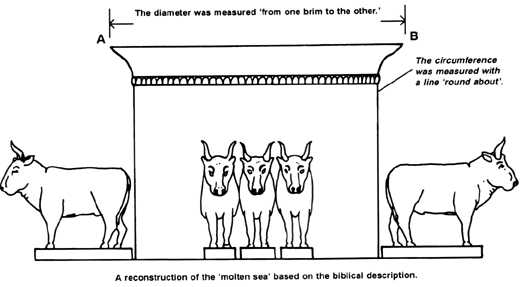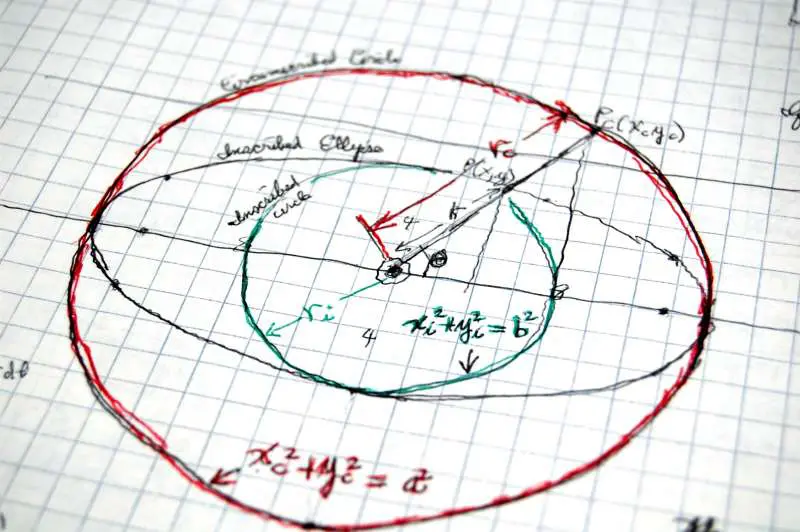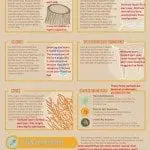In 1 Kings 7:23 there is an intriguing statement: ‘And he [Hiram on behalf of King Solomon] made a molten sea, ten cubits from the one brim to the other: it was round all about, and his height was five cubits: and a line of thirty cubits did compass it round about.’ A similar account is given in the parallel passage in 2 Chronicles 4:2.
From time to time sceptics have used these verses to ridicule the accuracy of the Bible by claiming that, if one uses the figures stated, the circumference of the vessel divided by its diameter gives 3.0, instead of the value pi π, 3.14159…).1
Closer examination shows there are at least two possible explanations.
- The first concerns the meaning of the word cubit, and how it would have been used in measuring the vessel. A cubit was the length of a man’s forearm from the elbow to the extended fingertips. The Hebrew cubit was about 45 centimetres (18 inches). It is obvious that a man’s forearm does not readily lend itself to the measurement of fractions of a forearm. In the Bible half a cubit is mentioned several times, but there is no mention of a third part of a cubit or a fourth part of a cubit, even though these fractions of ‘a third part’ and ‘a fourth part’ were used in volume and weight measurements.2 It therefore seems highly probable that any measurement of more than half a cubit would have been counted as a full cubit, and any measurement of less than half a cubit would have been rounded down to the nearest full cubit.From 1 Kings 7:23 (‘a line of thirty cubits did compass it round about’), it appears that the circumference was measured with ‘a line’, i.e. a piece of string or cord on which the distance was marked, and this length would then have been measured off in cubits by the measurer, using his own or someone else’s forearm, or possibly a cubit-long rod. Similarly the diameter would have been marked on a line and ‘cubitized’ in the same way.If the actual diameter was 9.65 cubits, for example, this would have been reckoned as 10 cubits. The actual circumference would then have been 30.32 cubits. This would have been reckoned as 30 cubits (9.6 cubits diameter gives 30.14 circumference, and so on). The ratio of true circumference to true diameter would then have been 30.32÷ 9.65 = 3.14, the true value for pi, even though the measured value (i.e. to the nearest cubit) was 30 ÷ 10 = 3.While the above seems reasonable, and the Ask ‘Dr Math’ Forum agrees that there is no error in the Bible here, we have no way of knowing for certain whether the measurements were approximated in this way. However, even if it is assumed that the measurements given were precisely 10 and 30 cubits, the following appears to provide a definitive answer.
- Verse 26 of 1 Kings 7 says that the vessel in question had a brim which ‘was wrought like the brim of a cup, with flowers of lilies’(KJV), or a rim ‘like the rim of a cup, like a lily blossom’ (NIV), i.e. the brim or rim turned outward, suggesting the curvature of a lily.3 It is believed by Bible scholars to have looked like the drawing below.4

Let us consider the details given in 1 Kings 7:23 and 2 Chronicles 4:2. These are:
- The diameter of 10 cubits was measured ‘from brim to brim’ (v. 23), i.e. from the topmost point of the brim on one side to the topmost point of the brim on the other side (points A and B in the diagram).
- The circumference of 30 cubits was measured with a line, ‘round about’ (v. 23), i.e. the most natural meaning of these words is that they refer to the circumference of the outside of the main body of the tank, measured by a string pulled tightly around the vesselbelow the brim. It is very obvious that the diameter of the main body of the tank was less than the diameter of the top of the brim. And it is also obvious that the circumference of 30 cubits could have been measured at any point down the vertical sides of the vessel, below the brim. For a measured circumference of 30 cubits, we can calculate what the external diameter of the vessel would have been at that point from the formula:
diameter =circumference ÷ pi =30 cubits ÷ 3.14 =9.55 cubits.
Thus the external diameter of the vessel at the point where the circumference was measured must have been 9.55 cubits.5
It is thus abundantly clear that the Bible does not defy geometry with regard to the value of pi, and in particular it does not say that pi equals 3.0. Skeptics who allege an inaccuracy are wrong, because they fail to take into account all the data. The Bible is reliable, and seeming discrepancies vanish on closer examination. [See also Does the Bible Give a Wrong Value for Pi? from Tekton Apologetics Ministry.]
References and notes
- Pi, or the ratio of the circumference of a circle to its diameter, is what has been known as an irrational number or infinite non-repeating decimal, of which the first digits are 3.1415926536 …. A value of 3.14 is close enough for our purposes.
- Abingdon’s Strong’s Exhaustive Concordance of the Bible.
- The International Standard Bible Encyclopedia 4:368, Eerdmans, Grand Rapids (Michigan), 1988.
- Adapted from reference 3. An NIV footnote (not part of the inspired text) to 1 Kings 7:26 suggests that the vessel had a greater volume than the above figures allow. This could indicate that the vessel may have been shaped more like a lily than imagined (i.e. part of it may have been bulbous), or that the conversion factor used by the NIV commentator was incorrect.
- Some have suggested that there is one other explanation that fits all the dimensions given in the biblical text, if the circumference measured refers to theinside of the vessel. (This is a possibility, although, as already stated, it was most likely the external circumference which was measured.) The diameter was 10 cubits or 4.50 metres, the circumference was 30 cubits or 13.50 metres, and the walls were ‘a hand breadth thick’ (verse 26) or 10 centimetres (to the nearest centimetre).6 If the diameter of 4.50 metres was the outside measurement, we subtract 10 centimetres x 2 (to allow for the thickness of the wall on either side) to arrive at a figure of 4.30 metres for the internal diameter of the vessel, and we can now calculate the internal circumference using the formula:
circumference = diameter= 4.3 metres x 3.14
= 13.50 metres
= 30 cubitswhich is exactly the figure given in 1 Kings 7:23. But as shown, there is no need to resort to this solution.
- The New Encyclopædia Britannica, Vol. 5, p.677, 1992.







A third explanation:
A closer value of pi can be achieved by taking into account 1 kings 7:26, it describes the thickness of the molten sea, and the volume.
If the circumference was measured on the INSIDE of the rim, which would be valuable for calculating volume, then the value of pi in the text would be 3.139.
1 kings 7:23- 10 cubits from brim to brim – (180″)
30 cubits around (540″)
1 kings 7:26 – the walls were “an hand breath thick”. (4″ thick)
And it contained 2,000 baths
540″ circumference
172″ diameter
540 divided by 172 equals 3.139 ( close to pi, 3.14)